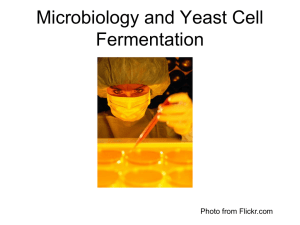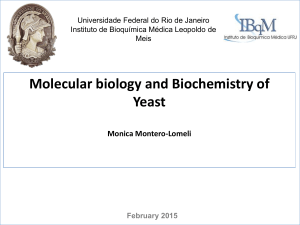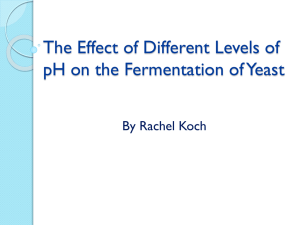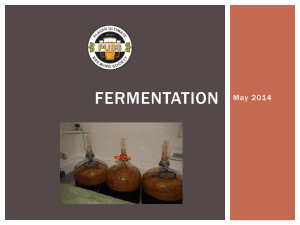Brandt_B - Energy Postgraduate Conference
advertisement
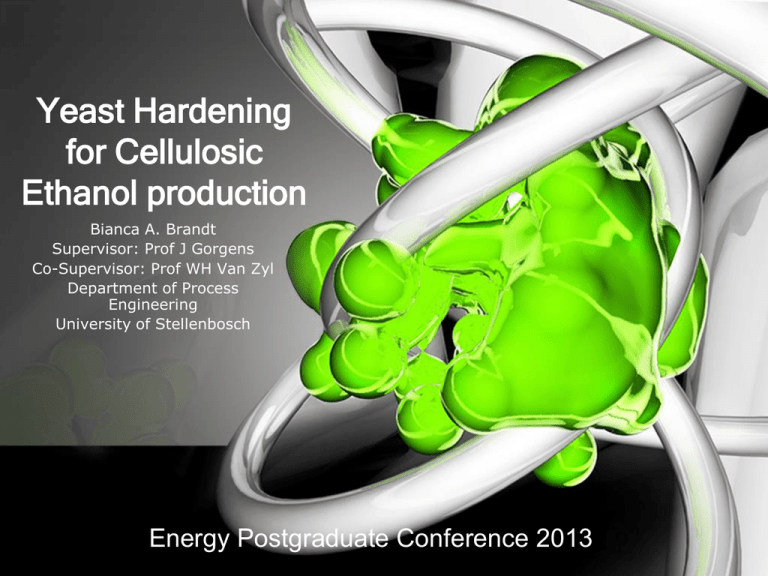
Yeast Hardening for Cellulosic Ethanol production Bianca A. Brandt Supervisor: Prof J Gorgens Co-Supervisor: Prof WH Van Zyl Department of Process Engineering University of Stellenbosch Energy Postgraduate Conference 2013 Introduction • Growing global move towards sustainable green energy production – spurred by dependence on rapidly depleting finite fossil fuels – environmental and socio-economic concerns • Studies into Alternative Clean, Renewable and Sustainable energy resources: – solar-electric/thermal, hydroelectric, geothermal, tidal, wave, wind and ocean thermal power systems – furthermore, a great deal of work has gone into the development of biofuels Introduction • Why Biofuels? – vehicular transportation- energy stored easier in form of combustible hydrocarbons then as electricity or heat – compatible with current distribution systems – supplement and replace fossil fuels • A range of bio-fuels are currently being investigated • Bioethanol - benchmark biofuel – production based on a proven low cost technological platform – Brazil and USA - cost effective 1st generation bioethanol – sugar and starch • 2nd generation bioethanol from lignocelluloses Cellulosic Bioethanol • Bioethanol from Lignocellulose – cheap, renewable, easily available, under utilized resource – energy/fuel and suitable molecules which can replace petroleum products • Lignocellulose bioethanol production process – degradation of lignocellulose to fermentable sugars – fermentation of sugars to bioethanol Pretreatment Hydrolysis Fermentation • Optimum ethanol production bottle necked – suboptimal xylose utilization and release of microbial inhibitor molecules during biomass degradation Overcoming Inhibitor toxicity • Challenge – Release of inhibitor molecules during lignocellulose degradation – furans, phenolics and weak acids – severely impact yeast fermentation efficiency • Process Optimization – feedstock, pretreatment, hydrolysis conditions – fermentation strategies • Detoxification of hydrolysate – physical (evaporation); chemical (over-liming) – biological: microbial and enzymatic approaches • Shown detoxification costs can constitute 22% of total ethanol production cost (Ding et al., 2009) – economically limited – inhibitor specific and loss of fermentable sugars Overcoming Inhibitor toxicity • Sustainable cost effective bioethanol fermentation require “hardened” inhibitor resistant fermentation strains • Rational engineering approach – Genetic modification – yeast oxido-reductase detoxification genes – boost innate detoxification mechanisms of yeast – furfural, HMF, Formic acid – improved tolerance to specific inhibitor • Evolutionary engineering techniques – mutation and long term continuous cultures – simulate natural selection under selective pressure Hardening yeast • Despite on-going yeast hardening strategies • Inhibitor resistant fermentation strains remain elusive and highly sought after!! • Project aim : Generate “hardened” inhibitor resistant yeast strains • Approach which combine Novel rational metabolic engineering and evolutionary engineering Hardening yeast • Strain generation - Rational metabolic engineering – industrial xylose utilization base strains • Identify and select yeast detoxification genes from literature – combine specific detoxification genes with cell membrane stress response genes • Express inhibitor resistance genes in Saccharomyces cerevisiae – novel gene combinations – elucidate synergistic /antagonistic combinations Hardening yeast • Evolutionary engineering – – – – long term continuous cultures - bioreactor selective pressure – increasing concentrations of inhibitors further enhance inhibitor resistance evaluate fermentation efficiency in toxic hydrolysate • Novel “HARDENED” inhibitor resistant strains • Optimization of lignocellulosic bioethanol production Acknowledgements Supervisors: Prof J Gorgens and Prof WH Van Zyl Department of process engineering NRF - Financial Support Yeast Hardening for Cellulosic Ethanol production Bianca A. Brandt Supervisor: Prof J Gorgens Co-Supervisor: Prof WH Van Zyl Department of Process Engineering University of Stellenbosch Energy Postgraduate Conference 2013 Introduction • Growing global move towards sustainable green energy production – Spurred by dependence on rapidly depleting Finite Fossil fuels – Various environmental and socio-economic concerns • Studies into Alternative Clean, Renewable and Sustainable energy resources: – solar-electric/thermal, hydroelectric, geothermal, tidal, wave, wind and ocean thermal power systems – furthermore, a great deal of work has gone into the development of bio-fuels Introduction • Why Biofuels? – Vehicular transportation- energy stored easier in form of combustible hydrocarbons then as electricity or heat – compatible with current distribution systems – Supplement and replace fossil fuels • A range of bio-fuels are currently being investigate • Bioethanol - benchmark biofuel – production based on a proven low cost technological platform – Brazil and USA -cost effective 1st generation bioethanol – Sugar and starch • 2nd generation bioethanol from lignocelluloses Cellulosic Bioethanal • Bioethanol from Lignocellulose – cheap, renewable, easily available, under utilized resource – energy/fuel and suitable molecules which can replace petroleum products • Lignocellulose bioethanol production process – degradation of lignocellulose to fermentable sugars – fermentation of sugars to bioethanol Pretreatment Hydrolysis Fermentation • Optimum ethanol production bottle necked – suboptimal xylose utilization and release of microbial inhibitor molecules during biomass degradation Overcoming inhibitor toxicity • Challenge – Release of inhibitor molecules during lignocellulose degradation – furans, phenolics and weak acids – severely impact yeast fermentation efficiency • Process Optimization – feedstock, pretreatment, hydrolysis conditions – fermentation strategies • Detoxification of hydrolysate – physical (evaporation); chemical (over-liming) – biological: microbial and enzymatic approaches • Shown detoxification costs can constitute 22% of total ethanol production cost (Ding et al., 2009) – economically limited – inhibitor specific and loss of fermentable sugars Overcoming inhibitor toxicity • Sustainable cost effective bioethanol fermentation require “hardened” inhibitor resistant fermentation strains • Rational engineering approach – – – – Genetic modification – yeast oxido-reductase detoxification genes boost innate detoxification mechanisms of yeast furfural, HMF, Formic acid improved tolerance to specific inhibitor • Evolutionary engineering techniques – mutation and long term continuous cultures – simulate natural selection under selective pressure Hardening yeast • Despite on-going yeast hardening strategies • Inhibitor resistant fermentation strains remain elusive and highly sought after!! • Project aim : Generate “hardened” inhibitor resistant yeast strains • Approach which combine Novel rational metabolic engineering and evolutionary engineering Hardening yeast • Strain generation - Rational metabolic engineering – Industrial xylose utilization base strains • Identify and select yeast detoxification genes from literature – Combine specific detoxification genes with cell membrane stress response genes • Express inhibitor resistance genes in Saccharomyces cerevisiae – novel gene combinations – elucidate synergistic /antagonistic combinations Hardening yeast • Evolutionary engineering – – – – long term continuous cultures - bioreactor selective pressure – increasing concentrations of inhibitors further enhance inhibitor resistance evaluate fermentation efficiency in toxic hydrolysate • Novel “HARDENED” inhibitor resistant strains • Optimization of lignocellulosic bioethanol production Acknowledgements Supervisors: Prof J Gorgens and Prof WH Van Zyl Department of process engineering NRF - Financial Support


